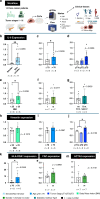The influence of clinical risk factors on the classification of human cancer-associated fibroblasts in PDAC and pancreatitis patients
- PMID: 40523922
- PMCID: PMC12170909
- DOI: 10.1038/s44276-025-00150-5
The influence of clinical risk factors on the classification of human cancer-associated fibroblasts in PDAC and pancreatitis patients
Abstract
Cancer-associated fibroblasts (CAFs) constitute an important cell population in the microenvironment of pancreatic cancer. They can arise from disease-associated fibroblasts (DAFs) to support or restrain tumor growth. How many CAF subtypes exist and what signals drive their development is unclear. Currently, there are three commonly accepted subtypes, namely myofibroblast-like (myCAF), immunomodulatory (iCAF), and antigen-presenting (apCAF). Here, we analyzed the correlation between clinical risk factors with the proportion of each CAF subtype. In our patient cohort (n = 21), we investigated DAFs from patients with chronic pancreatitis (CP) and CAFs from pancreatic ductal adenocarcinoma (PDAC) patients after surgical resection via flow cytometry and RNA expression analysis. The expression of iCAF marker Interleukin-6 displayed significant differences depending on lifestyle factors, such as smoking status, age, and Body Mass Index (BMI). The apCAF marker HLA-DQA1 correlated with age. The largest difference showed the quantitative difference of apCAF markers in ~40% of PDAC- and ~20% of CP patients. In conclusion, clinical risk factors may influence the prevelance of specific CAF subsets. Unraveling the complex interplay between CAFs and tumor cells is crucial for novel therapies to improve long-term survival for pancreatic cancer patients.
© 2025. The Author(s).
Conflict of interest statement
Competing interests: The authors declare no competing interests. Ethics approval and consent to participate: This study was approved by the ethics committees of the University Hospital Carl Gustav Carus Dresden and the University Hospital Halle (Ethical approval EK 76032013 Dresden, Ethical approval 037 Halle). Written informed consent was obtained from all patients. The study was performed in accordance with the Declaration of Helsinki.
Figures





Similar articles
-
Molecular feature-based classification of retroperitoneal liposarcoma: a prospective cohort study.Elife. 2025 May 23;14:RP100887. doi: 10.7554/eLife.100887. Elife. 2025. PMID: 40407808 Free PMC article.
-
Assessing the comparative effects of interventions in COPD: a tutorial on network meta-analysis for clinicians.Respir Res. 2024 Dec 21;25(1):438. doi: 10.1186/s12931-024-03056-x. Respir Res. 2024. PMID: 39709425 Free PMC article. Review.
-
Psychometric properties of the Chinese version of the pros and cons of anorexia nervosa (P-CAN-C) scale: a validation study in patients with anorexia nervosa.J Eat Disord. 2025 Jun 16;13(1):111. doi: 10.1186/s40337-025-01314-x. J Eat Disord. 2025. PMID: 40524259 Free PMC article.
-
Towards a patient-centred definition for atopic dermatitis flare: a qualitative study of adults with atopic dermatitis.Br J Dermatol. 2024 Jun 20;191(1):82-91. doi: 10.1093/bjd/ljae037. Br J Dermatol. 2024. PMID: 38287887
-
Defining disease severity in atopic dermatitis and psoriasis for the application to biomarker research: an interdisciplinary perspective.Br J Dermatol. 2024 Jun 20;191(1):14-23. doi: 10.1093/bjd/ljae080. Br J Dermatol. 2024. PMID: 38419411 Free PMC article. Review.
References
-
- Kleeff J, Korc M, Apte M, La Vecchia C, Johnson CD, Biankin AV, et al. Pancreatic cancer. Nat Rev Dis Primer. 2016;2:16022. - PubMed
LinkOut - more resources
Full Text Sources
Research Materials
Miscellaneous
